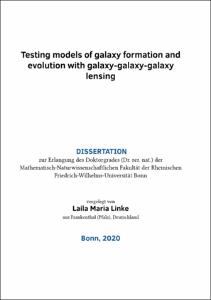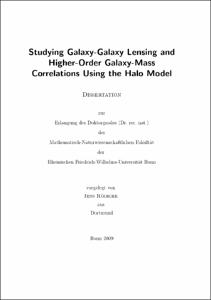Linke, Laila Maria: Testing models of galaxy formation and evolution with galaxy-galaxy-galaxy lensing. - Bonn, 2021. - Dissertation, Rheinische Friedrich-Wilhelms-Universität Bonn.
Online-Ausgabe in bonndoc: https://nbn-resolving.org/urn:nbn:de:hbz:5-61762
Online-Ausgabe in bonndoc: https://nbn-resolving.org/urn:nbn:de:hbz:5-61762
@phdthesis{handle:20.500.11811/9015,
urn: https://nbn-resolving.org/urn:nbn:de:hbz:5-61762,
author = {{Laila Maria Linke}},
title = {Testing models of galaxy formation and evolution with galaxy-galaxy-galaxy lensing},
school = {Rheinische Friedrich-Wilhelms-Universität Bonn},
year = 2021,
month = mar,
note = {Explaining the formation and evolution of galaxies is a fundamental issue in modern astronomy. Several competing models try to explain how galaxies form and predict the relationship between galaxies and dark matter. A prominent class of these models are semi-analytic models of galaxy formation and evolution (SAMs). They combine analytical prescriptions for small-scale physical effects with cosmological simulations of the dark matter. To test these models, their predictions, in particular for the correlation of dark and visible matter, need to be compared to observations.
The ideal tool to study the relationship between dark and visible matter is gravitational lensing. This effect describes how matter bends light rays and distorts the images of far-away objects. By comparing the position of nearby galaxies to this distortion, we can directly measure their correlation with the (predominantly dark) matter distribution. In this thesis, we use gravitational lensing to test dierent models of galaxy formation and evolution. We concentrate on the correlation of galaxy pairs with the matter field. This correlation can be measured with galaxy-galaxy-galaxy lensing (G3L). Here, the position of galaxy pairs is correlated to the distortion by the matter field. This correlation effectively measures how much more dark matter exists around pairs of galaxies compared to single galaxies. We investigate how well different models predict G3L by comparing them to observations.
First, we improve the commonly-used estimator for G3L to enhance the precision and accuracy of the measurement. These improvements include a weighting of galaxy pairs according to their redshifts, an adaptive binning of the galaxy-galaxy-matter correlation function, and accounting for the magnification of galaxies by the cosmic large-scale-structure. We test the improvements with realistic simulated data based on the Millennium Run (MR) with the SAM by Henriques et al. (2015, H15). Our improvements increase the signal-to-noise ratio by 35% on average at angular scales between 0.01 and 100. They also remove the bias of the G3L estimator at angular scales below 10, which was originally up to 40%. The signal due to lens magniffication is approximately 10% of the total signal.
Next, we test the SAMs by H15 and Lagos et al. (2012, L12) by comparing their predictions for G3L to measurements in the overlap of the Kilo-Degree Survey (KiDS), VISTA Kilodegree Infrared Galaxy survey (VIKING), and Galaxy And Mass Assembly survey (GAMA) (KV450 x GAMA). Galaxies into two colour- and five stellar-mass samples. We measure G3L for ‘mixed lens pairs’ with galaxies from different samples, as well as for ‘unmixed lens pairs’ with galaxies from the same sample. Predictions by the H15 SAM for the G3L signal agree with the observations for all colour-selected samples and all but one stellar-mass-selected sample with 95% confidence. Deviations occur for lenses with stellar masses below 9.5 h-1 M☉ at scales below 0.2 h-1 Mpc. Predictions by the L12 SAM for stellar-mass selected samples and red galaxies are significantly higher than observed, while the predicted signal for blue galaxy pairs is too low. We conclude that the L12 SAM predicts more pairs of low stellar mass and red galaxies than the H15 SAM and the observations, as well as fewer pairs of blue galaxies. This difference increases towards the centre of the galaxies’ host halos. Likely explanations are different treatments of environmental effects by the SAMs and different models of the initial mass function.
Lastly, we propose an analytical model for G3L. We investigate the impact and physical meaning of the model parameters and find that G3L is sensitive to all but one of them. Then, we constrain the parameters by fitting the model to the observations in KV450 x GAMA with a multidimensional optimization routine. The resulting best fit agrees with the measurement at the 95% confidence level. The parameter values indicate that red galaxies form in more massive dark matter halos than blue galaxies and that red and blue galaxies are positively correlated. We conclude that the halo model can describe G3L.
In conclusion, not all models of galaxy evolution and formation predict the correlation of galaxy pairs with the matter distribution accurately. The halo model can, despite its simple assumptions, reproduce the observed G3L with plausible parameters. SAMs, when tuned to the right parameters for the physical model, accurately predict the observed G3L signal. However, this is not the case for all SAMs. Consequently, G3L provides a stringent test for models of galaxy formation and evolution.},
url = {https://hdl.handle.net/20.500.11811/9015}
}
urn: https://nbn-resolving.org/urn:nbn:de:hbz:5-61762,
author = {{Laila Maria Linke}},
title = {Testing models of galaxy formation and evolution with galaxy-galaxy-galaxy lensing},
school = {Rheinische Friedrich-Wilhelms-Universität Bonn},
year = 2021,
month = mar,
note = {Explaining the formation and evolution of galaxies is a fundamental issue in modern astronomy. Several competing models try to explain how galaxies form and predict the relationship between galaxies and dark matter. A prominent class of these models are semi-analytic models of galaxy formation and evolution (SAMs). They combine analytical prescriptions for small-scale physical effects with cosmological simulations of the dark matter. To test these models, their predictions, in particular for the correlation of dark and visible matter, need to be compared to observations.
The ideal tool to study the relationship between dark and visible matter is gravitational lensing. This effect describes how matter bends light rays and distorts the images of far-away objects. By comparing the position of nearby galaxies to this distortion, we can directly measure their correlation with the (predominantly dark) matter distribution. In this thesis, we use gravitational lensing to test dierent models of galaxy formation and evolution. We concentrate on the correlation of galaxy pairs with the matter field. This correlation can be measured with galaxy-galaxy-galaxy lensing (G3L). Here, the position of galaxy pairs is correlated to the distortion by the matter field. This correlation effectively measures how much more dark matter exists around pairs of galaxies compared to single galaxies. We investigate how well different models predict G3L by comparing them to observations.
First, we improve the commonly-used estimator for G3L to enhance the precision and accuracy of the measurement. These improvements include a weighting of galaxy pairs according to their redshifts, an adaptive binning of the galaxy-galaxy-matter correlation function, and accounting for the magnification of galaxies by the cosmic large-scale-structure. We test the improvements with realistic simulated data based on the Millennium Run (MR) with the SAM by Henriques et al. (2015, H15). Our improvements increase the signal-to-noise ratio by 35% on average at angular scales between 0.01 and 100. They also remove the bias of the G3L estimator at angular scales below 10, which was originally up to 40%. The signal due to lens magniffication is approximately 10% of the total signal.
Next, we test the SAMs by H15 and Lagos et al. (2012, L12) by comparing their predictions for G3L to measurements in the overlap of the Kilo-Degree Survey (KiDS), VISTA Kilodegree Infrared Galaxy survey (VIKING), and Galaxy And Mass Assembly survey (GAMA) (KV450 x GAMA). Galaxies into two colour- and five stellar-mass samples. We measure G3L for ‘mixed lens pairs’ with galaxies from different samples, as well as for ‘unmixed lens pairs’ with galaxies from the same sample. Predictions by the H15 SAM for the G3L signal agree with the observations for all colour-selected samples and all but one stellar-mass-selected sample with 95% confidence. Deviations occur for lenses with stellar masses below 9.5 h-1 M☉ at scales below 0.2 h-1 Mpc. Predictions by the L12 SAM for stellar-mass selected samples and red galaxies are significantly higher than observed, while the predicted signal for blue galaxy pairs is too low. We conclude that the L12 SAM predicts more pairs of low stellar mass and red galaxies than the H15 SAM and the observations, as well as fewer pairs of blue galaxies. This difference increases towards the centre of the galaxies’ host halos. Likely explanations are different treatments of environmental effects by the SAMs and different models of the initial mass function.
Lastly, we propose an analytical model for G3L. We investigate the impact and physical meaning of the model parameters and find that G3L is sensitive to all but one of them. Then, we constrain the parameters by fitting the model to the observations in KV450 x GAMA with a multidimensional optimization routine. The resulting best fit agrees with the measurement at the 95% confidence level. The parameter values indicate that red galaxies form in more massive dark matter halos than blue galaxies and that red and blue galaxies are positively correlated. We conclude that the halo model can describe G3L.
In conclusion, not all models of galaxy evolution and formation predict the correlation of galaxy pairs with the matter distribution accurately. The halo model can, despite its simple assumptions, reproduce the observed G3L with plausible parameters. SAMs, when tuned to the right parameters for the physical model, accurately predict the observed G3L signal. However, this is not the case for all SAMs. Consequently, G3L provides a stringent test for models of galaxy formation and evolution.},
url = {https://hdl.handle.net/20.500.11811/9015}
}









